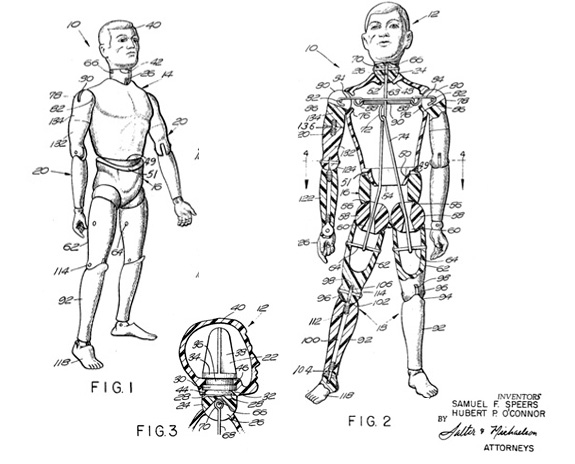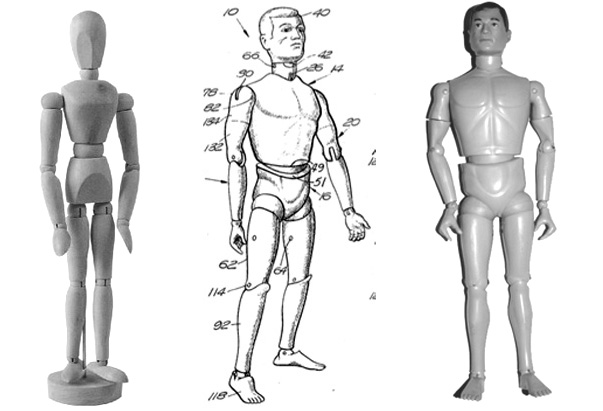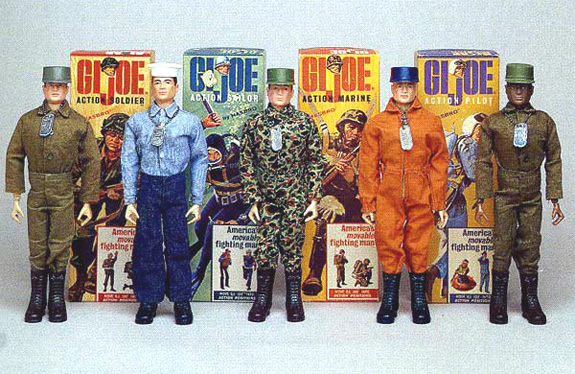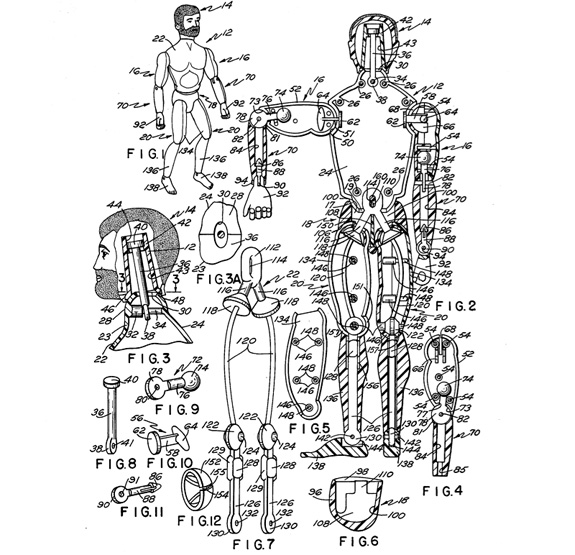Now You Know the History of G.I. Joe. And Knowing Is Half The Battle
The evolution of the All American Hero from artist’s mannequin to action figure
![]()

U.S. Patent 3,277,602 for a “toy figure having movable joints” aka the original G.I. Joe. Issued on October 11, 1966 (image: Google Patents)
In the G.I. Joe sequel opening this weekend, the original “Joe” is played by the over 50-year-old Bruce Willis – the other All-American Hero. In reality, the nearly 50-year-old G.I. Joe was an 11 1/2-inch-tall plastic action figure produced by former pencil makers the Hassenfeld Brothers, who the world would eventually come to know simply as “Hasbro.” In the late 1930s the Hassenfeld Brother –Henry, Hilal, Herman– expanded their textile and school supply business to include toys. The move proved lucrative and by 1960, they had become one of America’s largest toy companies (largely thanks to the success of Mr. Potato Head). But Hasbro’s biggest hit came in 1964 with the release of G.I. Joe, the world’s first action figure.

from left to right: a wooden artist’s mannequin, the G.I. Joe design, and the final product.
The original, prototype figure was invented by Don Levine, Vice President and Director of Marketing and Development at Hasbro. Levine was fascinated with the “razor-razor blade” model that made Mattel’s Barbie such a success and was determined to create a similar toy for boys. Today, we might call it the “printer-print cartridge” model; the idea being that the initial toy/razor/printer is just a means to get consumers to purchase additional accessories. While walking by an art store one day, Levine noticed a wooden artists mannequin in a window display and was struck with an epiphany:
Suddenly it occurred to me that we could create something truly magnificent if there was a way to produce figures that moved and posed any which way the human body did. Tin and plastic soldiers have been favorites of children as long as there have been toys; it seemed to me that this fully articulated man could be a giant step forward. From that point on, it was a matter of conveying this vision to my staff at Hasbro.
When the figure hit the market in 1964 it was a runaway success. Within two years, G.I. Joe accounted for almost 66 percent of Hasbro’s profits. The key characteristic driving its popularity was the 19 points of articulation and high-quality assembly. According to the Hassenfeld Brothers’ patent, it was their aim to create a “toy figure or doll having movable joints that closely simulate the movable portions of the human anatomy.” That was probably the first and last time the figure was ever referred to as a doll. The company strictly prohibited the term and refused to sell their action figure to any retailer that used it. The patented designs also placed a premium on safety, durability and cost-effective manufacturing. It was important, for example, that no metal springs were used in the assembly and that different heads could be used on the same figure – thereby creating product variability while keep manufacturing costs low.
Hasbro simultaneously produced four figures to represent the four branches of America’s armed forces: Rocky the Movable Fighting Man represented the Army, Skip for the Navy, Ace Fighter Pilot was obviously a proud member of the Air Force, and Rocky, apparently serving double duty, was also a Marine. Each figure came with basic fatigues, boots, cap and dog tag, while the packaging enticed children with images of other uniforms and accessories. The “G.I Joe” moniker was created to encompass the entire brand. The name “G.I. Joe” was inspired by a 1945 film about film about war correspondent Ernie Pyle, titled The Story of G.I. JOE. The name was perfect, Levine remembers, “because ‘Government Issue Joe’ was a real everyman title.”
Of course, with the popularity of Hasbro’s action figure came man imitators. The fact that the human figure can’t be trademarked or copyrighted posed a problem for a company hoping to have the exclusive rights to a popular toy. Luckily for Hasbro, fate intervened and early production errors gave the first G.I. Joes a facial scar and an inverted thumbnail. These design flaws became the signifying marks of the true Hasbro G.I. Joe and helped Hasbro pursue cases of infringement.
But G.I. has long been a metric of culture. And as tensions escalated in Vietnam, public opinion turned against all things military in nature, G.I. Joe was discharged for a time in the late 1960s
When the toy was relaunched in the ’70′s near the end of American involvement in Vietnam, it had a macho new beard and an intimidating “Kung-fu grip” – both were developed after the original All American Hero completed years of training at secret temple hidden deep in the Himalayas. Actually, the toys were redesigned and renamed to be less militaristic and more adventure-oriented – “adventurer” replaced the solider, “aquanaut” replaced the naval officer, etc. Despite the changes, their re-enlistment may have been too soon, because Hasbro ended its production on its G.I. Joe line in 1978.
In the 1980s, the U.S. political climate changed and as military toys gained in popularity, the G.I. Joe line was relaunched with dramatically redesigned actions figures that now stood only 3 3/4 inches tall. The new size that was inspired by the success of recent Star Wars figures, but may also have reflected the continued effects of the OPEC oil embargo of the 1970s, which raised the prices of plastic. Whereas the original Joes were generic representations of the American military, these later versions were highly specialized antiterrorist commandos complete with their own exotic code names, elaborate back stories, and unique personalities, which were created with the help of Marvel Comics. And for the first time, G.I. Joe was also given a specific enemy to fight: the international terrorist organization COBRA. Along with the new figures, a cartoon series was launched in 1983 as part of a savvy marketing campaign. The cartoon was made possible thanks to government deregulation during the administration of President Reagan that resulted in new rules for children’s television programming. “G.I. Joe: An All American Hero” was one of the first cartoons to benefit from these new rules, which permitted the FCC to air violent war cartoons featuring toy products as the main characters. The strategy worked. The National Coalition on Television Violence reported a 350% increase in the sale of war toys between 1982-1985 – no doubt largely due to the cross-platform success of G.I. Joe.
Levine has said that “G.I. Joe is a universal archetype of good.” It is also a metric of American culture. During the Civil Rights Movement, a heroic African-American Joe was introduced. As the space program gained momentum, an astronaut was introduced. And of course, in the 1980s when flamboyant terrorist organizations started cloning ancient world leaders and building mindless android soldiers, those were introduced as well.
In some form or another, G.I. Joe figures have been on shelves since the 1982 relaunch. When asked about its enduring quality, Levine suggested that G.I. Joes are “a very empowering toy for kids. A child has a character that is his or hers to direct through whatever adventure happens to come up on that particular day. The child…is able to explore all manner of heroic and exciting possibilities, whether it be as a deep sea dive, astronaut, or jet pilot. That kind of make-believe is something every generation thrives on.” Levin’s opinions on the importance of “make believe” have a lot of merit, but something was lost as the G.I. Joes became more and more specific in the 1980s and children were increasingly being told how to play. High profile movies may further limit the possibilities of play, but their popularity ensures that G.I. Joe will continue to fight or freedom wherever there’s trouble.
SOURCES:
“Questions for Discussion with Don Levine, The Father of G.I. Joe,” Headquarters Quarterly; “Hasbro, Inc. History,” Funding Universe; Encyclopedia of Play in Today’s Society, ed. Rodney P. Carlisle (Thousand Oaks, CA: SAGE, 2009); Dan Fletcher, “A Secret History of G.I. Joe,” Time(August 7, 2009); Roger Chapman, Culture Wars: An Encyclopedia of Issues, Viewpoints, and Voices (M.E. Sharpe, 2010); Google Patents
/https://tf-cmsv2-smithsonianmag-media.s3.amazonaws.com/accounts/headshot/Jimmy-Stamp-240.jpg)



/https://tf-cmsv2-smithsonianmag-media.s3.amazonaws.com/accounts/headshot/Jimmy-Stamp-240.jpg)